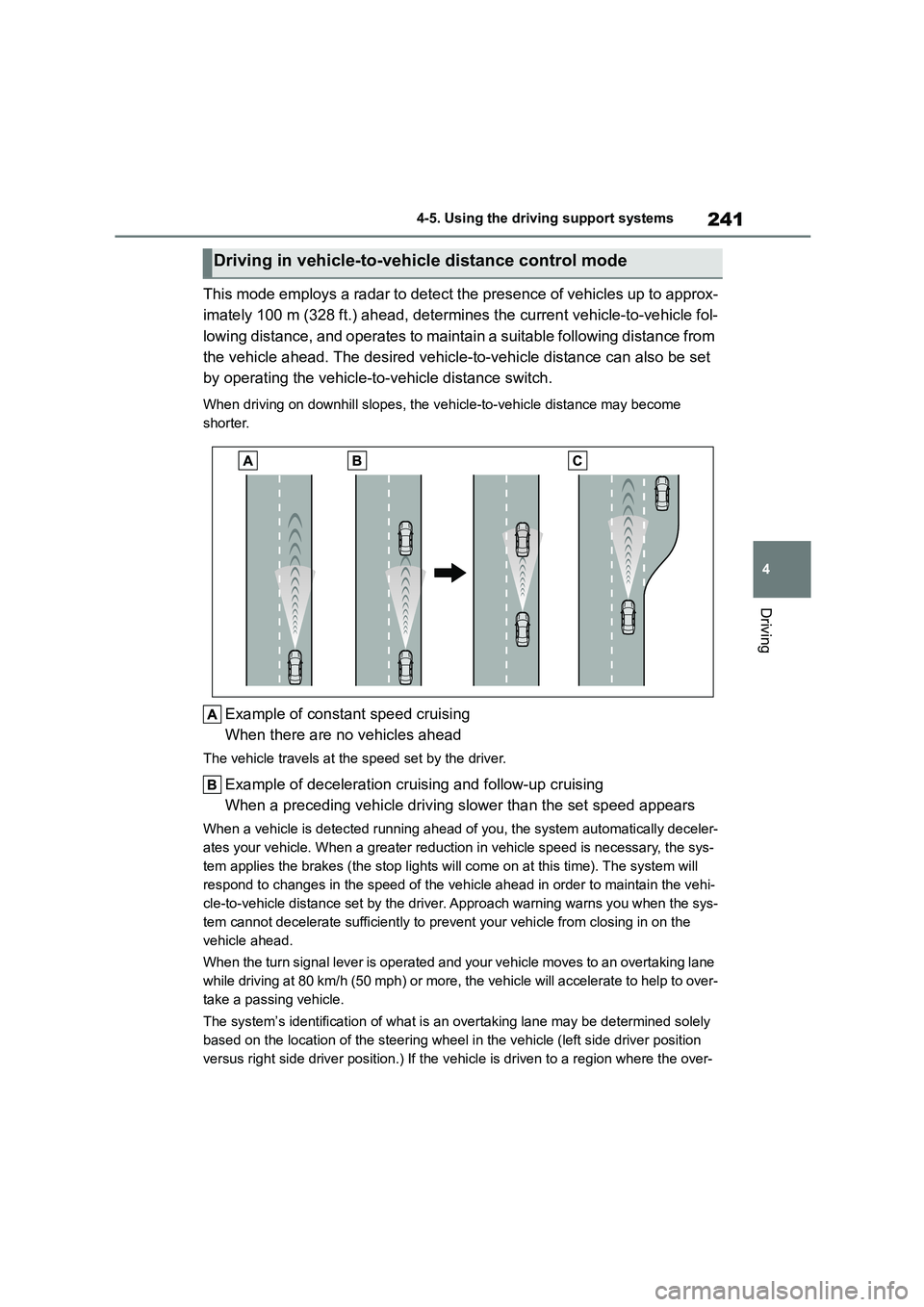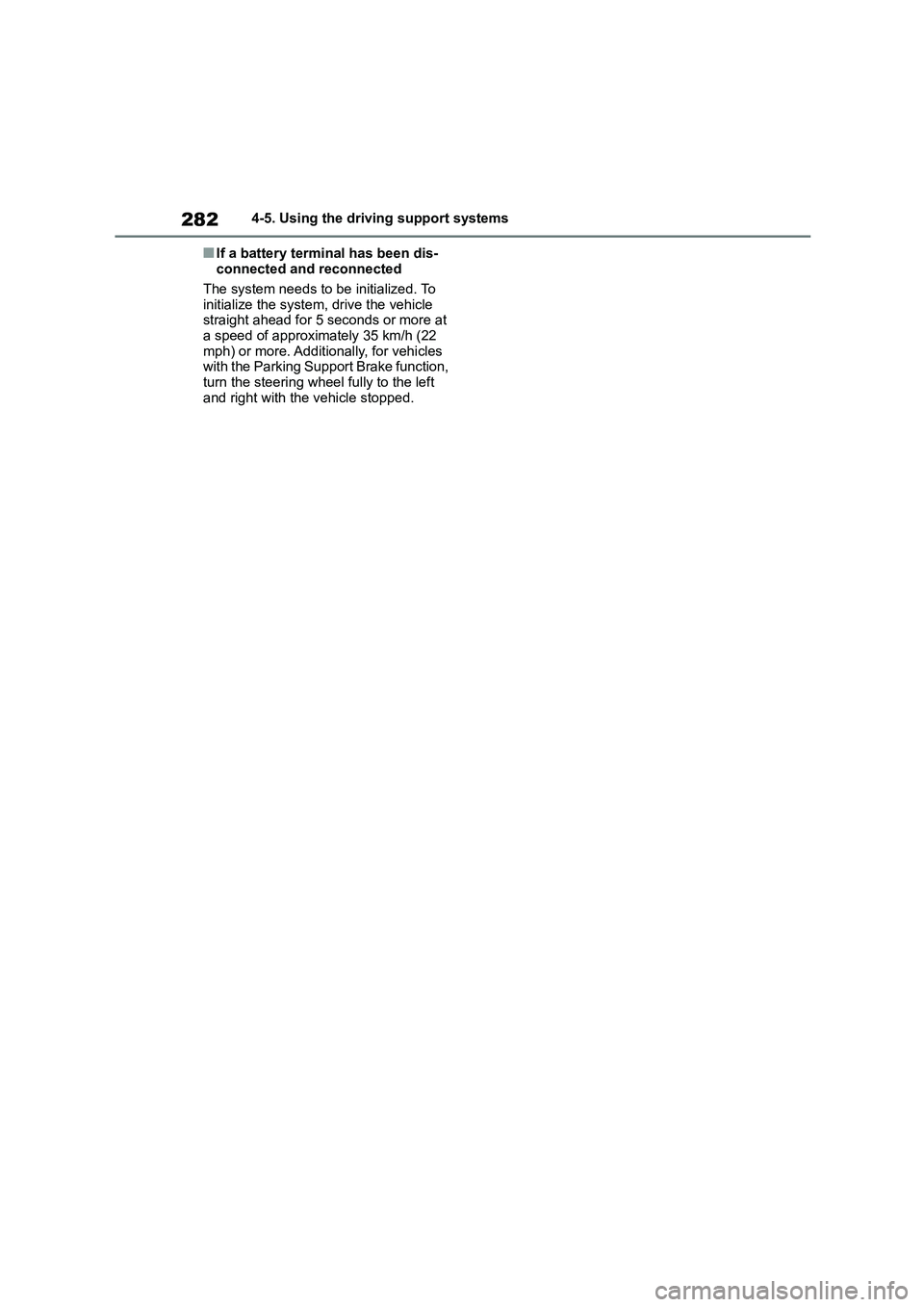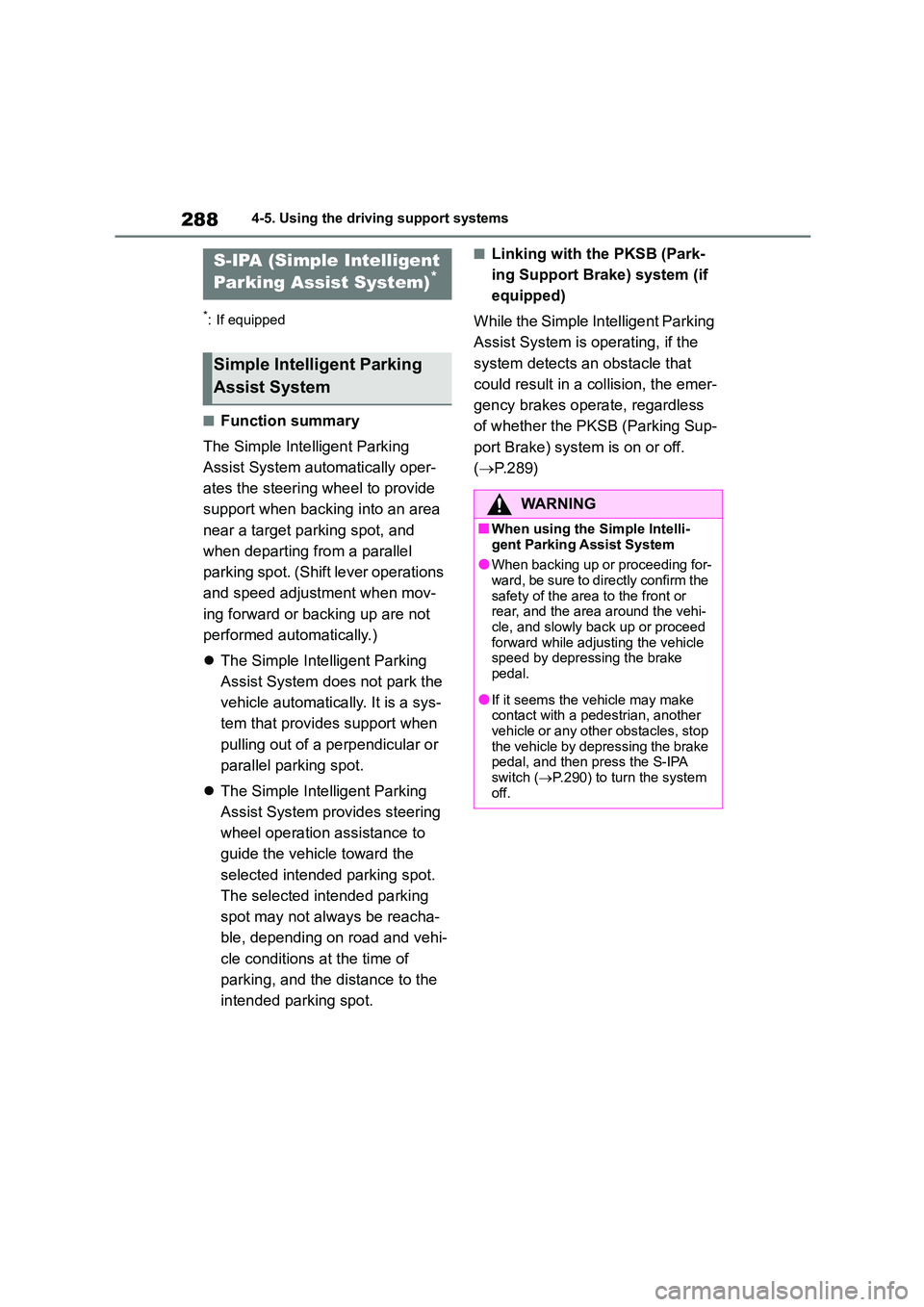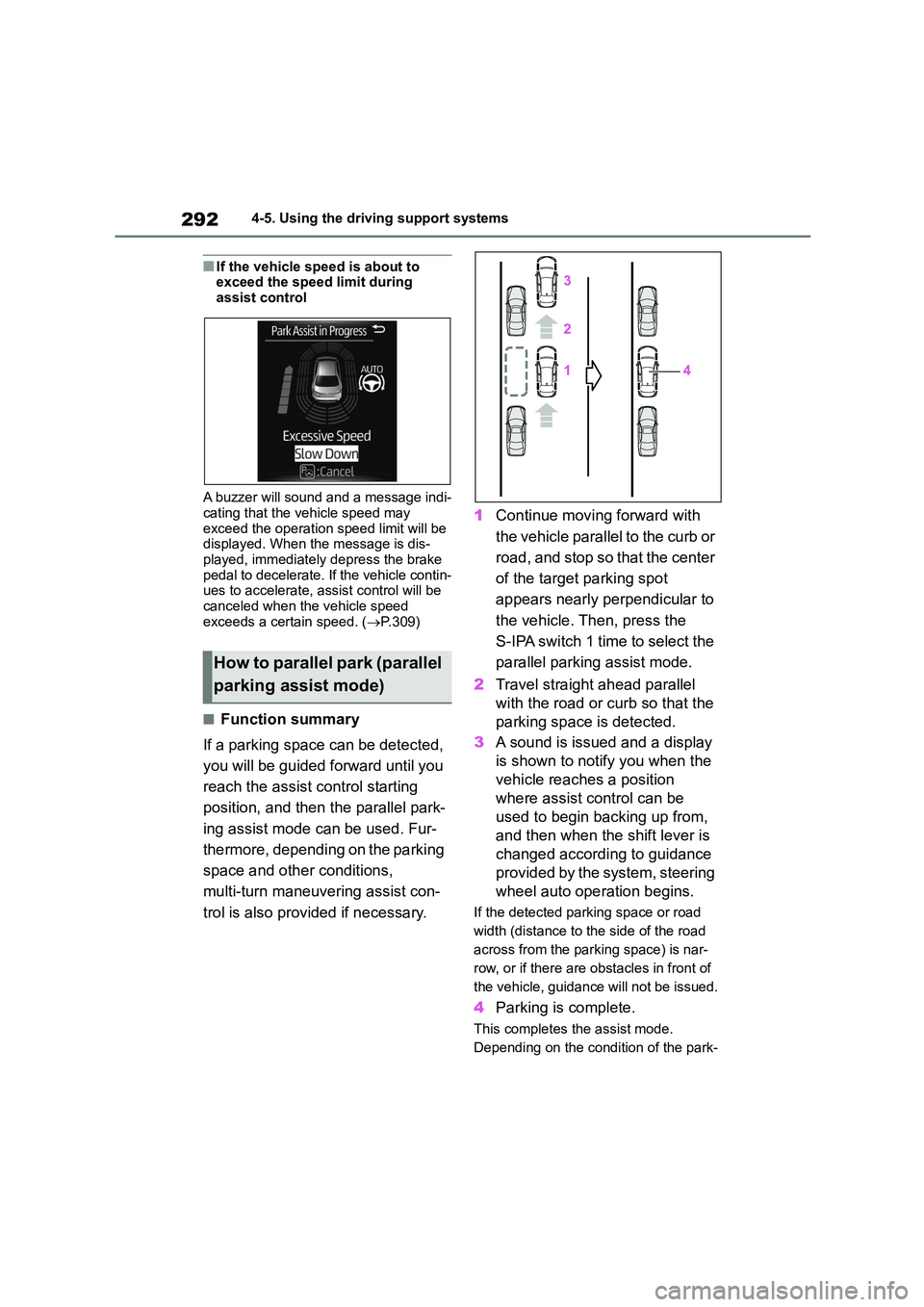2022 TOYOTA COROLLA steering
[x] Cancel search: steeringPage 243 of 678

241
4
4-5. Using the driving support systems
Driving
This mode employs a radar to detect the presence of vehicles up to approx-
imately 100 m (328 ft.) ahead, determines the current vehicle-to-vehicle fol-
lowing distance, and operates to maintain a suitable following distance from
the vehicle ahead. The desired vehicle-to-vehicle distance can also be set
by operating the vehicle-to -vehicle distance switch.
When driving on downhill slopes, the vehicle-to-vehicle distance may become
shorter.
Example of const ant speed cruising
When there are no vehicles ahead
The vehicle travels at the speed set by the driver.
Example of deceleration cruising and follow-up cruising
When a preceding vehicle driving slower than the set speed appears
When a vehicle is de tected running ahead of you, the system automatically deceler-
ates your vehicle. When a greater reduction in vehicle speed is necessary, the sys-
tem applies the brakes (the stop lights will come on at this time). The system will
respond to changes in the speed of the vehicle ahead in order to maintain the vehi-
cle-to-vehicle distance set by the driver. Approach warning warns you when the sys-
tem cannot decelerate sufficiently to prevent your vehicle from closing in on the
vehicle ahead.
When the turn signal lever is operated and your vehicle moves to an overtaking lane
while driving at 80 km/h (50 mph) or more, the vehicle will accelerate to help to over-
take a passing vehicle.
The system’s identificat ion of what is an overtaking lane may be determined solely
based on the location of the steering wheel in the vehicle (left side driver position
versus right side driver position.) If the v ehicle is driven to a region where the over-
Driving in vehicle-to-vehicle distance control mode
Page 250 of 678

2484-5. Using the driving support systems
the luggage compartment, etc.)
●Preceding vehicle has an extremely
high ground clearance
■Conditions under which the vehi-
cle-to-vehicle distance control
mode may not function correctly
In the case of the following conditions,
operate the brake pedal (or accelerator
pedal, depending on the situation) as necessary.
As the sensor may not be able to cor-
rectly detect vehicles ahead, the system may not operate properly.
●When the road curves or when the lanes are narrow
●When steering wheel operation or your position in the lane is unstable
●When the vehicle ahead of you decel-
erates suddenly
●When driving on a road surrounded by
a structure, such as in a tunnel or on a bridge
●While the vehicle speed is decreasing to the set speed after the vehicle
accelerates by depr essing the accel-
erator pedal
Page 267 of 678

265
4
4-5. Using the driving support systems
Driving
■The system can be operated when
●The engine switch is in ON.
●Toyota parking assi st-sensor function
is on.
●The vehicle speed is less than about
10 km/h (6 mph).
●A shift lever other than P is selected.
●Steering wheel is turned approxi-
mately 90° or more (Front side sen-
sors, rear side sensors) (if equipped)
■Object warning function (if equipped)
When an object in the side areas is
within the vehicle co urse while the vehi- cle is moving forward or backward, this
function inform the driver by the display
and the buzzer.
Object
Calculated vehicle course
■Object detection in side areas (if equipped)
●Objects in the side areas are detected while driving by scanning the side
areas with the side sensors. Recog-
nized objects are retained in memory for up to approximately 2 minutes.
●Objects may not be detected in the side areas until the scan completes.
After the engine switch is turned on,
scanning completes after driving the vehicle for a short period of time.
●When an object such as another vehi-cle, pedestrian or animal is detected
by the side sensors, the object may
continue to be detected even after it has left the side sensor detection
area.
WA R N I N G
●Do not subject the surrounding area
of the sensor to a strong impact. If
subjected to an impact, have the vehicle inspected by any authorized
Toyota retailer or Toyota authorized
repairer, or any reliable repairer. If the front or rear bumper needs to
be removed/installed or replaced,
contact any authorized Toyota
retailer or Toyota authorized repairer, or any reliable repairer.
●Do not modify, disassemble or paint the sensors.
●Do not attach a license plate cover.
●Keep your tires properly inflated.
■When to disable the function
In the following situations, disable the
function as it may operate even though there is no possibility of a colli-
sion.
●Failing to observe the warnings
above.
●A non-genuine Toyota suspension
(lowered suspension, etc.) is
installed.
■Notes when washing the vehicle
Do not apply intensive bursts of water or steam to the sensor area.
Doing so may result in the sensor
malfunctioning.
●When using a high pressure
washer to wash the vehicle, do not spray the sensors directly, as doing
so may cause a sensor to malfunc-
tion.
●When using steam to clean the
vehicle, do not direct steam too close to the sensors as doing so
may cause a sensor to malfunction.
Page 284 of 678

2824-5. Using the driving support systems
■If a battery terminal has been dis-
connected and reconnected
The system needs to be initialized. To
initialize the system, drive the vehicle
straight ahead for 5 seconds or more at a speed of approximately 35 km/h (22
mph) or more. Additionally, for vehicles
with the Parking Support Brake function, turn the steering wheel fully to the left
and right with the vehicle stopped.
Page 290 of 678

2884-5. Using the driving support systems
*: If equipped
■Function summary
The Simple Inte lligent Parking
Assist System automatically oper-
ates the steering wheel to provide
support when backing into an area
near a target parking spot, and
when departing from a parallel
parking spot. (Shift lever operations
and speed adjustment when mov-
ing forward or backing up are not
performed automatically.)
The Simple Intelligent Parking
Assist System does not park the
vehicle automatically. It is a sys-
tem that provides support when
pulling out of a perpendicular or
parallel parking spot.
The Simple Intelligent Parking
Assist System provides steering
wheel operation assistance to
guide the vehicle toward the
selected intended parking spot.
The selected intended parking
spot may not always be reacha-
ble, depending on road and vehi-
cle conditions at the time of
parking, and the distance to the
intended parking spot.
■Linking with the PKSB (Park-
ing Support Brake) system (if
equipped)
While the Simple Intelligent Parking
Assist System is operating, if the
system detects an obstacle that
could result in a collision, the emer-
gency brakes operate, regardless
of whether the PKSB (Parking Sup-
port Brake) system is on or off.
( P. 2 8 9 )
S-IPA (Simple Intelligent
Parking Assist System)*
Simple Intelligent Parking
Assist System
WA R N I N G
■When using the Simple Intelli-
gent Parking Assist System
●When backing up or proceeding for- ward, be sure to directly confirm the
safety of the area to the front or
rear, and the area around the vehi- cle, and slowly back up or proceed
forward while adjusting the vehicle
speed by depressing the brake pedal.
●If it seems the vehicle may make contact with a pedestrian, another
vehicle or any other obstacles, stop
the vehicle by depressing the brake pedal, and then press the S-IPA
switch ( P.290) to turn the system
off.
Page 293 of 678

291
4
4-5. Using the driving support systems
Driving
Displayed when the assist mode can be
changed and the system can be turned
off or on using the S-IPA switch.
Toyota parking assist-sensor
display/door position
(open/close) display
P.263
Steering wheel auto operation
display
Displays when the steering wheel auto
operation is being performed.
Advice display
Follow the instructions on the display
and perform any indicated operations.
As an example, the illustration shows
the display indicating it is necessary to
depress the brake pedal in order to
control the vehicle speed and to con-
firm the safety of your surroundings.
■S-IPA indicator inside the meter ( P. 8 3 )
This indicator illuminates when the
steering wheel auto operation is being performed by the Simple Intelligent
Parking Assist Syst em. After control
ends, the indicator blinks for a short period of time and then turns off.
■Toyota parking assist-sensor
pop-up display
While the Simple Intelligent Parking
Assist System is operating, if the PKSB (Parking Support Brak e) system detects
an obstacle, the Toyota parking
assist-sensor display automatically pops up on the guidance screen ( P.263),
regardless of whether the PKSB (Park-
ing Support Brake) system is on or off. ( P.264)
Assist mode will be canceled or
stopped in the following cases.
Assist control is canceled when
The system temperature preser-
vation function operates
There is a system malfunction
System determined that the
parking environment is not suita-
ble for assist to continue
When assist control is canceled,
firmly grasp the steering wheel,
depress the brake pedal and stop
the vehicle.
Start again from the beginning, as
the system will already be
canceled. When continuing to park
manually, operate the steering
wheel as you normally would.
Assist control is stopped when
The steering wheel is operated
The vehicle speed exceeds 7
km/h (4 mph) during assist con-
trol
The PKSB (Parking Support
Brake) system operates
When assist contro l is stopped, it
can be resumed by following the
guidance shown on the screen.
Canceling or stopping assist
mode
Page 294 of 678

2924-5. Using the driving support systems
■If the vehicle speed is about to exceed the speed limit during
assist control
A buzzer will sound and a message indi-
cating that the vehicle speed may
exceed the operation speed limit will be displayed. When the message is dis-
played, immediately depress the brake
pedal to decelerate. If the vehicle contin- ues to accelerate, a ssist control will be
canceled when the vehicle speed
exceeds a certain speed. ( P.309)
■Function summary
If a parking space can be detected,
you will be guided forward until you
reach the assist control starting
position, and then the parallel park-
ing assist mode can be used. Fur-
thermore, depending on the parking
space and other conditions,
multi-turn maneuvering assist con-
trol is also provided if necessary.
1 Continue moving forward with
the vehicle parallel to the curb or
road, and stop so that the center
of the target parking spot
appears nearly perpendicular to
the vehicle. Then, press the
S-IPA switch 1 time to select the
parallel parking assist mode.
2 Travel straight ahead parallel
with the road or curb so that the
parking space is detected.
3 A sound is issued and a display
is shown to notify you when the
vehicle reaches a position
where assist control can be
used to begin backing up from,
and then when the shift lever is
changed according to guidance
provided by the system, steering
wheel auto operation begins.
If the detected parking space or road
width (distance to the side of the road
across from the parking space) is nar-
row, or if there are obstacles in front of
the vehicle, guidance will not be issued.
4 Parking is complete.
This completes the assist mode.
Depending on the condition of the park-
How to parallel park (parallel
parking assist mode)
Page 295 of 678

293
4
4-5. Using the driving support systems
Driving
ing space, guidance to starting points
for moving forward and backing up, as
well as the steering wheel auto opera-
tion, are repeated any time multi-turn
maneuvering is necessary following
step 3 from the time the vehicle begins
backing up until parking completes.
■Parking
1 Stop so that the center of the
target parking spot appears
nearly perpendicular to vehicle.
Then, press the S-IPA switch 1
time and check that the display
on the multi-information display
switches to “Parallel Parking”.
The mode switches each time
the S-IPA switch is pressed.
( P.290)
When the vehicle speed is
approximately 30 km/h (19 mph)
or higher, pressing the S-IPA
switch will not cause the screen
to switch to the “Parallel Parking”
display.
2 Travel straight ahead parallel
with the road (or curb), and
maintain a gap of approximately
1 m (3.3 ft.) from any parked
vehicles.
1 m (3.3 ft.)
Proceed slowly.
The system will begin searching
for a parking space.
While searching for a space, the
turn signal lever ( P.171) can
be operated to select a parking
space on the left or right.
When stopping the function,
press the S-IPA switch once to
turn the function off.
When a parking space is
detected, the screen will change.